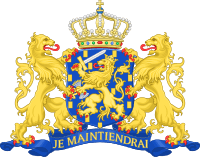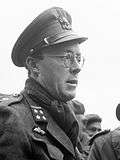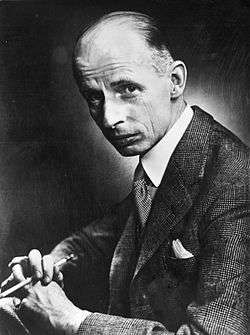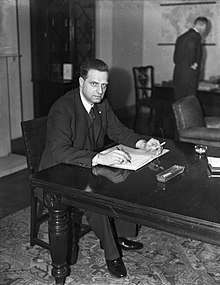Third Gerbrandy cabinet
The Third Gerbrandy cabinet, also called the Fourth London cabinet was the Dutch government-in-exile from 23 February 1945 until 25 June 1945. The cabinet was formed by the political parties Roman Catholic State Party (RKSP), Anti-Revolutionary Party (ARP) and the Free-thinking Democratic League (VDB) following the resignation of Second Gerbrandy cabinet on 27 January 1945. The national unity government (War cabinet) was the last of four war cabinets of the government-in-exile in London during World War II.[1]
| Third Gerbrandy cabinet Fourth London cabinet | |
|---|---|
40th Cabinet of the Netherlands | |
| Date formed | 23 February 1945 |
| Date dissolved | 25 June 1945 (Demissionary from 12 May 1945) |
| People and organisations | |
| Head of state | Queen Wilhelmina |
| Head of government | Pieter Sjoerds Gerbrandy |
| No. of ministers | 14 |
| Member party | Roman Catholic State Party (RKSP) Anti-Revolutionary Party (ARP) Free-thinking Democratic League (VDB) |
| Status in legislature | National unity government (War cabinet) |
| History | |
| Legislature term(s) | 1937–1946 |
| Predecessor | Second Gerbrandy cabinet |
| Successor | Schermerhorn–Drees cabinet |
 |
|---|
| This article is part of a series on the politics and government of Netherlands |
|
|
Local government
|
|
Related topics |
Formation
On 27 January 1945 the Second Gerbrandy cabinet fell after Minister of the Interior Jaap Burger (SDAP) was asked to resign by Prime Minister Pieter Sjoerds Gerbrandy (ARP) after holding a radio speech, differentiating between "wrongful" Dutch civilians (foute Nederlanders) and Dutch civilians who made a mistake (Nederlanders die een fout hebben gemaakt). But because Pieter Sjoerds Gerbrandy did not discuss this with rest of the cabinet all Social Democratic Workers' Party ministers resigned in response. The demissionary cabinet continued until the installation of the Third Gerbrandy cabinet on 23 February 1945.
Term
Although the cabinet was officially seated in London, Minister of the Interior Louis Beel (RKSP) were already present in the earlier liberated southern part of the Netherlands in Oisterwijk where he introduced a temporary arrangement for municipal and provincial governments after the war. Emergency municipal councils are to be appointed by a separate electoral colleges. An important part of the administrative tasks in the liberated part of the Netherlands is executed under the authority of the Military Command by the Commander-in-chief of the Armed forces General Prince Bernhard of Lippe-Biesterfeld and Major general Henk Kruls.
Cabinet Members
Not a part of the cabinet, but an important executive position:
| Military Command | Title/Position | Term of office | Military Branch | |||
|---|---|---|---|---|---|---|
 |
General Prince Bernhard of Lippe-Biesterfeld (1911–2004) |
Commander-in-chief | Armed Forces | 3 September 1944 – 13 September 1945 |
Army | |
- Retained Retained this position from the previous cabinet.
- Ad interim Served ad interim.
References
- "Gerbrandy in Londen" (in Dutch). Andere Tijden. 18 March 2003. Retrieved 9 June 2018.
.jpg)
.jpg)

.jpg)

.jpg)
.jpg)
.jpg)
.jpg)
.jpg)
.jpg)